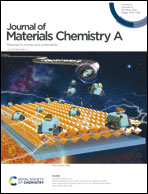Engineering cation defect-mediated Z-scheme photocatalysts for a highly efficient and stable photocatalytic hydrogen production†
Abstract
The construction of Z-scheme heterojunctions has been demonstrated as an effective strategy to improve photocatalytic hydrogen (H2) production efficiency. Herein, a Zn vacancy defect-mediated direct Z-scheme CdS/ZnS (CSZS–VZn) heterojunction was developed to optimize the H2 production performance, and the introduction of cation defects in ZnS could regulate the band structure of the photocatalyst by forming additional energy levels within the band gap and help to form ohmic contacts. The CSZS–VZn heterojunction exhibited a H2 evolution rate of 46.63 mmol h−1 g−1 under visible light illumination in an aqueous Na2S/Na2SO3 system, which was about 388 and 1727 times higher than those of CdS and Zn-vacancy ZnS (ZnS–VZn), respectively. The enhanced photocatalytic activity of CSZS–VZn was mainly attributed to the presence of Zn vacancy defects upon the formation of the Z-scheme heterojunction structure, by which the photogenerated electrons were trapped in the Zn vacancy defect levels of ZnS and recombined with holes in the valence bands of CdS at heterojunction interfaces through ohmic contacts. In such a way, electrons in the conduction bands of CdS were boosted to participate in H2 evolution reactions and photocorrosion was suppressed. This work provides a viable design strategy via the engineering of cation defects in Z-scheme photocatalysts for photocatalytic H2 evolution.



 Please wait while we load your content...
Please wait while we load your content...